Study on the Vibration and Sound Radiation Performance of Micro-Perforated Laminated Cylindrical Shells
Abstract
:1. Introduction
2. Finite Element Theory of Acoustic–Vibration Coupling
2.1. Inner Acoustic Field
2.2. Outer Acoustic Field
3. Numerical Simulation Analysis
3.1. Establishment and Verification of a Finite Element Model for Cylindrical Shells
3.1.1. Model Establishment
3.1.2. Validation of Finite Element Calculations
3.2. Establishment and Validation of a Micro-Perforated Finite Element Model
4. The Influence of Micro-Perforated Shells on the Vibration and Acoustic Radiation of Micro-Perforated Sandwich Cylindrical Shells
4.1. The Influence of a Sandwich Structure on the Vibration and Acoustic Radiation Performance of Cylindrical Shells
4.2. The Influence of Micro-Perforation on the Vibration and Acoustic Radiation Performance of Cylindrical Shells
5. The Influence of Foam Laying on the Vibration and Acoustic Radiation Performance of Micro-Perforated Sandwich Cylindrical Shells
5.1. The Influence of Foam Type on the Vibration and Acoustic Radiation Performance of Cylindrical Shells
5.2. The Influence of Sound-Absorbing Foam Thickness on the Vibration and Acoustic Radiation Performance of Cylindrical Shells
5.3. The Influence of Sound-Absorbing Foam Coverage Rate on the Vibration and Acoustic Radiation Performance of Cylindrical Shells
5.4. The Influence of Sound-Absorbing Foam Placement on the Vibration and Acoustic Radiation Performance of Cylindrical Shells
6. Conclusions
- Under the simultaneous excitation of point force and point source, perforations in the inner shell effectively reduce the radiation acoustic power level at the characteristic frequency of the shell and reduce the number of acoustic structural resonance peaks, thereby lowering the structural radiation acoustic power level. Within the selected parameter range, as the micro-perforation rate and perforation diameter increase, the overall structural radiation acoustic power level decreases significantly, and the corresponding peaks decrease. However, due to its narrow operating range, the reduction in the overall structural radiation acoustic power level is not significant;
- In the frequency range of 1–1000 Hz, the position of sound-absorbing foam has the most significant impact on the vibration and acoustic radiation performance of the structure within the 300–810 Hz frequency range. Various types of foam can lessen the acoustic power level caused by structural radiation, with polyurethane being the optimal choice for reducing it up to 11.14 dB. Nonetheless, the foam’s placement has no effect on the natural vibration frequencies of the structure. When the foam thickness varies within the 80–810 Hz frequency range, the overall level of acoustic power radiated by the structure declines as the foam thickness increases. The performance reaches its maximum at a thickness of 40 mm, resulting in a decrease of up to 11.14 dB;
- In the 300–810 Hz and 900–1000 Hz frequency ranges, as the sound-absorbing foam placement rate increases, the structural radiation acoustic power level gradually decreases, and the reduction values gradually diminish. Compared to the situation without the placement of sound-absorbing foam, the overall structural radiation acoustic power level is reduced by 0.4 dB, 0.77 dB, 0.94 dB, 1.16 dB, and 1.19 dB when 20%, 40%, 60%, 80%, and 100% foam is placed, respectively, indicating that the acoustic performance of the micro-perforated laminated cylindrical shell is optimal when fully equipped with foam;
- In the frequency range of 1–1000 Hz and with no change in foam thickness, a 60% placement rate has a minimal effect on the level of structural radiation acoustic power, as the foam thickness is less than 6% of the cavity radius and only the placement location was modified. This finding indicates that to achieve better noise reduction results in practical applications, the relationship between foam thickness and acoustic wavelength must be considered.
Author Contributions
Funding
Institutional Review Board Statement
Informed Consent Statement
Data Availability Statement
Conflicts of Interest
References
- Xin, F.X.; Lu, T.J.; Chen, C.Q. External Mean Flow Influence on Noise Transmission through Double-Leaf Aeroelastic Plates. AIAA J. 2009, 47, 1939–1951. [Google Scholar] [CrossRef]
- Fuchs, H.; Zha, X. Micro-Perforated Structures as Sound Absorbers—A Review and Outlook. Acta Acust. United Acust. 2006, 92, 139–146. [Google Scholar]
- Fuchs, H.; Zha, X. Acrylic-glass sound absorbers in the plenum of the deutscher bundestag. Appl. Acoust. 1997, 51, 211–217. [Google Scholar] [CrossRef]
- Hou, J.; Zhu, H.; Yuan, S.; Liao, J. Transmission loss of flexible micro-perforated muffler with flexible back cavity for water filled pipelines. Acta Acust. 2021, 46, 405–414. [Google Scholar]
- Tian, Y.; Chen, J.; Liu, Z.; Lu, W.; Chen, X.; Han, J. Application of Microporous Fiber Composite Acoustic Board in the Noise Control Engineering of Urban Substations. Smart Grid 2016, 4, 988–992. [Google Scholar]
- Hu, S.; Chen, S.; Wu, X.; Cai, J.; Li, T.; Peng, J. Study of Design and Performance of Composite Resonance Absorption Barrier. Ind. Saf. Environ. Prot. 2019, 45, 77–80,96. [Google Scholar]
- Yang, J.; Cai, J.; Shao, C. Sound Insulation Property of the Composite Structure with Micro-perforated Panels and Honeycomb Core. Noise Vib. Control 2013, 33, 122–125,176. [Google Scholar]
- Kang, J.; Brocklesby, M.W. Feasibility of applying micro-perforated absorbers in acoustic window systems. Appl. Acoust. 2005, 66, 669–689. [Google Scholar] [CrossRef]
- Zhang, Q.; Mao, Y.; Qi, D. Effect of perforation on the sound transmission through a double-walled cylindrical shell. J. Sound Vib. 2017, 410, 344–363. [Google Scholar] [CrossRef]
- Zhang, Q.; Mao, Y.; Qi, D. Analytical Modeling of the Vibro-Acoustic Response of a Double-Walled Cylindrical Shell with Microperforation Excited by Turbulent Boundary Layer Pressure Fluctuations. J. Vib. Acoust. 2017, 140, 021012. [Google Scholar] [CrossRef]
- Zhang, Q. Sound transmission through micro-perforated double-walled cylindrical shells lined with porous material. J. Sound Vib. 2020, 485, 115539. [Google Scholar] [CrossRef]
- Allard, J.F.; Atalla, N. Propagation of Sound in Porous Media: Modelling Sound Absorbing Materials, 2nd ed.; Wiley-Blackwell: Hoboken, NJ, USA, 2009; p. 358. [Google Scholar]
- Aditya, L.; Mahlia, T.M.I.; Rismanchi, B.; Ng, H.M.; Hasan, M.H.; Metselaar, H.S.C.; Muraza, O.; Aditiya, H.B. A review on insulation materials for energy conservation in buildings. Renew. Sustain. Energy Rev. 2017, 73, 1352–1365. [Google Scholar] [CrossRef]
- Zhou, J.; Bhaskar, A.; Zhang, X. Sound transmission through double cylindrical shells lined with porous material under turbulent boundary layer excitation. J. Sound Vib. 2015, 357, 253–268. [Google Scholar] [CrossRef]
- Oliazadeh, P.; Farshidianfar, A.; Crocker, M.J. Experimental and analytical investigation on sound transmission loss of cylindrical shells with absorbing material. J. Sound Vib. 2018, 434, 28–43. [Google Scholar] [CrossRef]
- Darvish Gohari, H.; Zarastvand, M.R.; Talebitooti, R. Acoustic performance prediction of a multilayered finite cylinder equipped with porous foam media. J. Vib. Control 2020, 26, 899–912. [Google Scholar] [CrossRef]
- Shahsavari, H.; Kornokar, M.; Talebitooti, R.; Daneshjou, K. The study of sound transmission through sandwich cylindrical shells with circumferentially corrugated cores filled with porous materials. Compos. Struct. 2022, 291, 291. [Google Scholar] [CrossRef]
- Yang, X.; Chen, M.; Zhao, Y.; Dong, W. Characteristics and calculation method of sound radiation of cylindrical shell with porous sound-absorbing material under acoustic excitation. Chin. J. Ship Res. 2023, 18, 97–106. [Google Scholar]
- Liu, Y.; Liu, J.; Pan, G.-X.; Guo, L.; Huang, Q. A Design Method for Vibration and Acoustic Reduction of the Power System in an Underwater Automobile Glider. Int. J. Acoust. Vib. 2022, 27, 233–244. [Google Scholar] [CrossRef]
- Gaul, L.; Wenzel, W. A coupled symmetric BE–FE method for acoustic fluid–structure interaction. Eng. Anal. Bound. Elem. 2002, 26, 629–636. [Google Scholar] [CrossRef]
- Zheng, Z.; Li, B.; Yan, S.; Qi, M.; Wang, N.; Kuang, W.; Wen, J.; Ma, Y. Acoustic radiation performance investigation of a double-walled cylindrical shell equipped with annular plates and porous foam media. J. Low Freq. Noise Vib. Act. Control 2022, 42, 851–865. [Google Scholar] [CrossRef]
- Berenger, J.P. A perfectly matched layer for the absorption of electromagnetic waves. J. Comput. Phys. 1994, 114, 185–200. [Google Scholar] [CrossRef]
- Zhan, F.; Xu, J. Virtual. Lab Acoustics Acoustic Simulation Calculations from Beginner to Proficient; Northwestern Polytechnical University Press Co., Ltd.: Xi’an, China, 2013. [Google Scholar]
- Jiang, C. Analysis of Vibro-Acoustic Characteristics of Double Cylindrical Shell Underwater Based on Precise Transfer Matrix Method. Master’s Thesis, Wuhan University of Technology, Wuhan, China, 2019. [Google Scholar]
- Wu, J.; Liu, Z.; Wang, Q. Prediction of Acoustic Properties of Sound-absorbing Structures with Composite Micro-perforated Panels. Noise Vib. Control 2022, 42, 203–208. [Google Scholar]
- Chen, M.; Luo, D.; Chen, X.; Shen, R. Analysis of sound radiation characteristics of complex double shells. Acta Acust. 2004, 29, 209–215. [Google Scholar]
- Floss, S.; Czwielong, F.; Becker, S.; Kaltenbacher, M. Micro-perforated panels for noise reduction. E I Elektrotech. Und Infstechnik. 2021, 138, 171–178. [Google Scholar] [CrossRef]
- Champoux, Y.; Allard, J.F. Dynamic tortuosity and bulk modulus in air-saturated porous media. J. Appl. Phys. 1991, 70, 1975–1979. [Google Scholar] [CrossRef]
- Johnson, D.L.; Koplik, J.; Dashen, R.F. Theory of dynamic permeability and tortuosity in fluid-saturated porous media. J. Fluid Mech. 1987, 176, 379–402. [Google Scholar] [CrossRef]
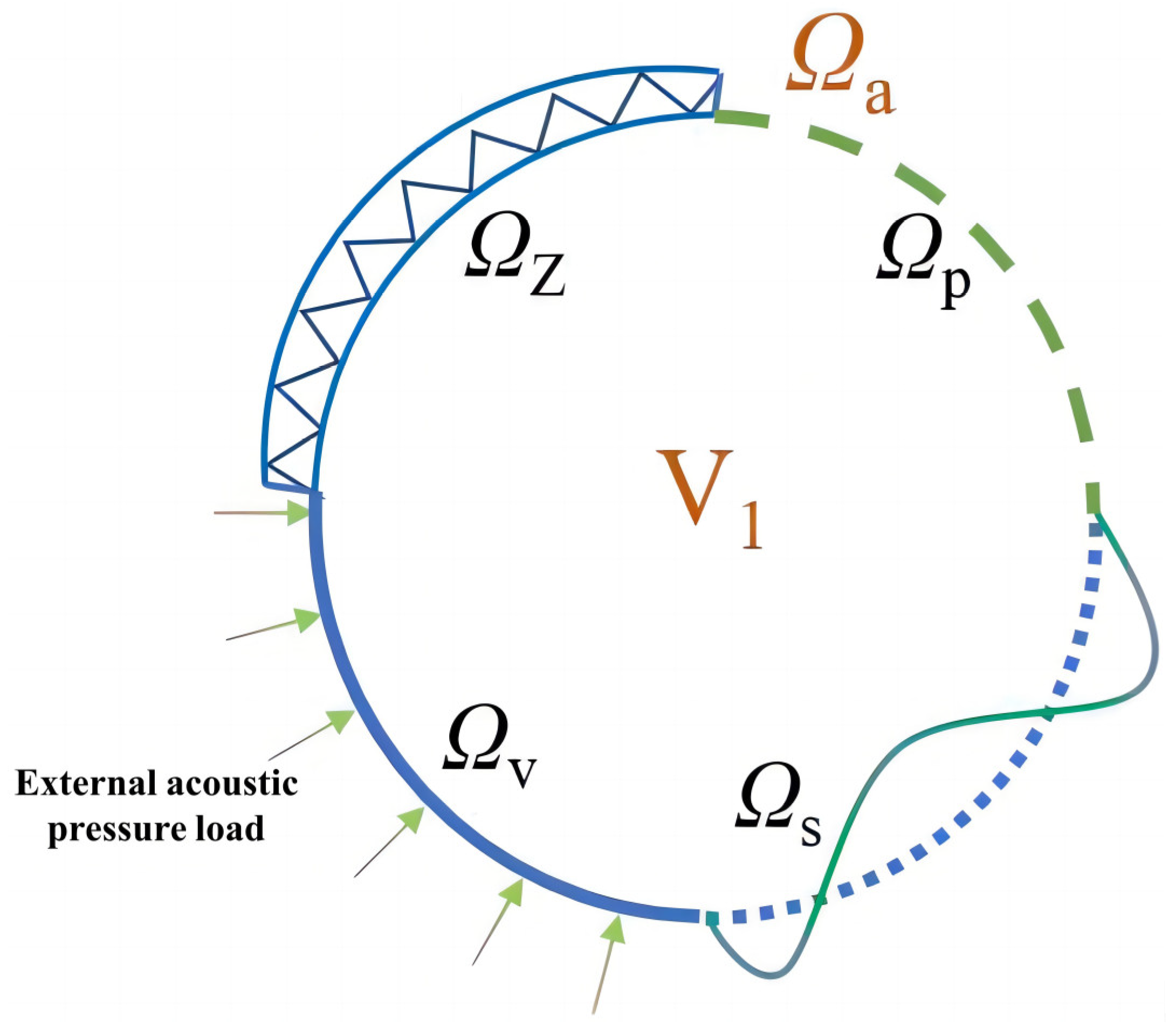

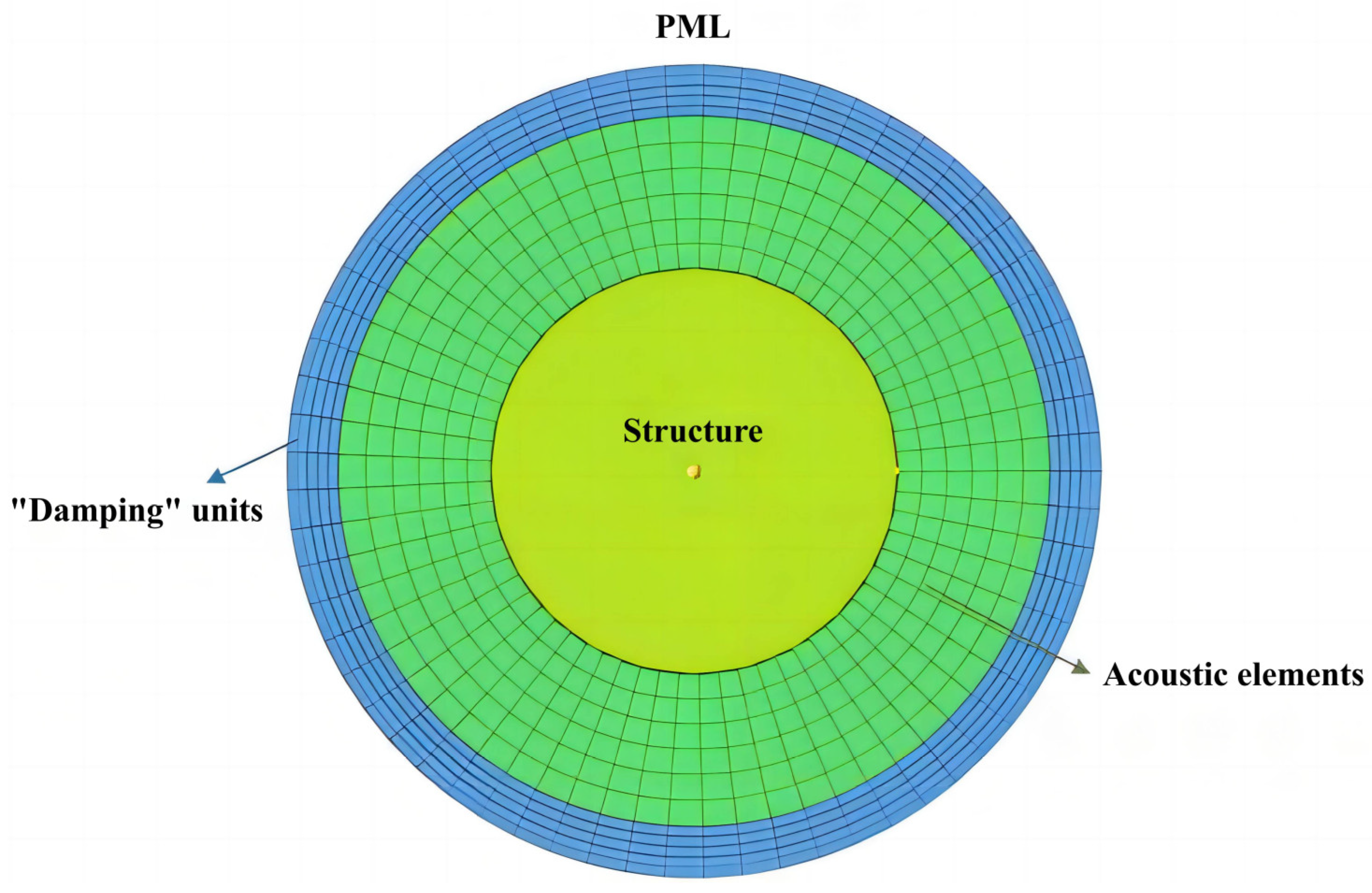
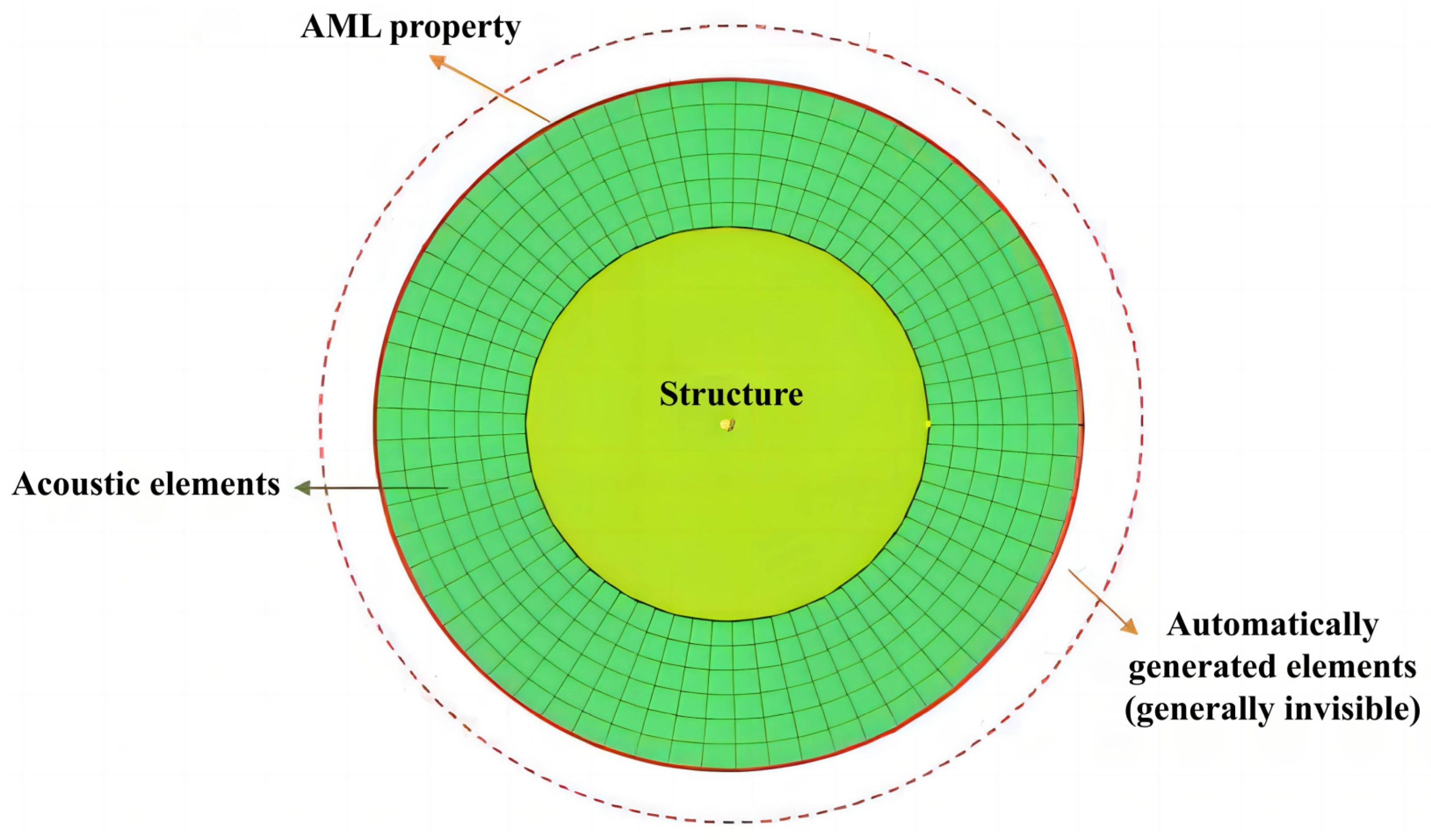
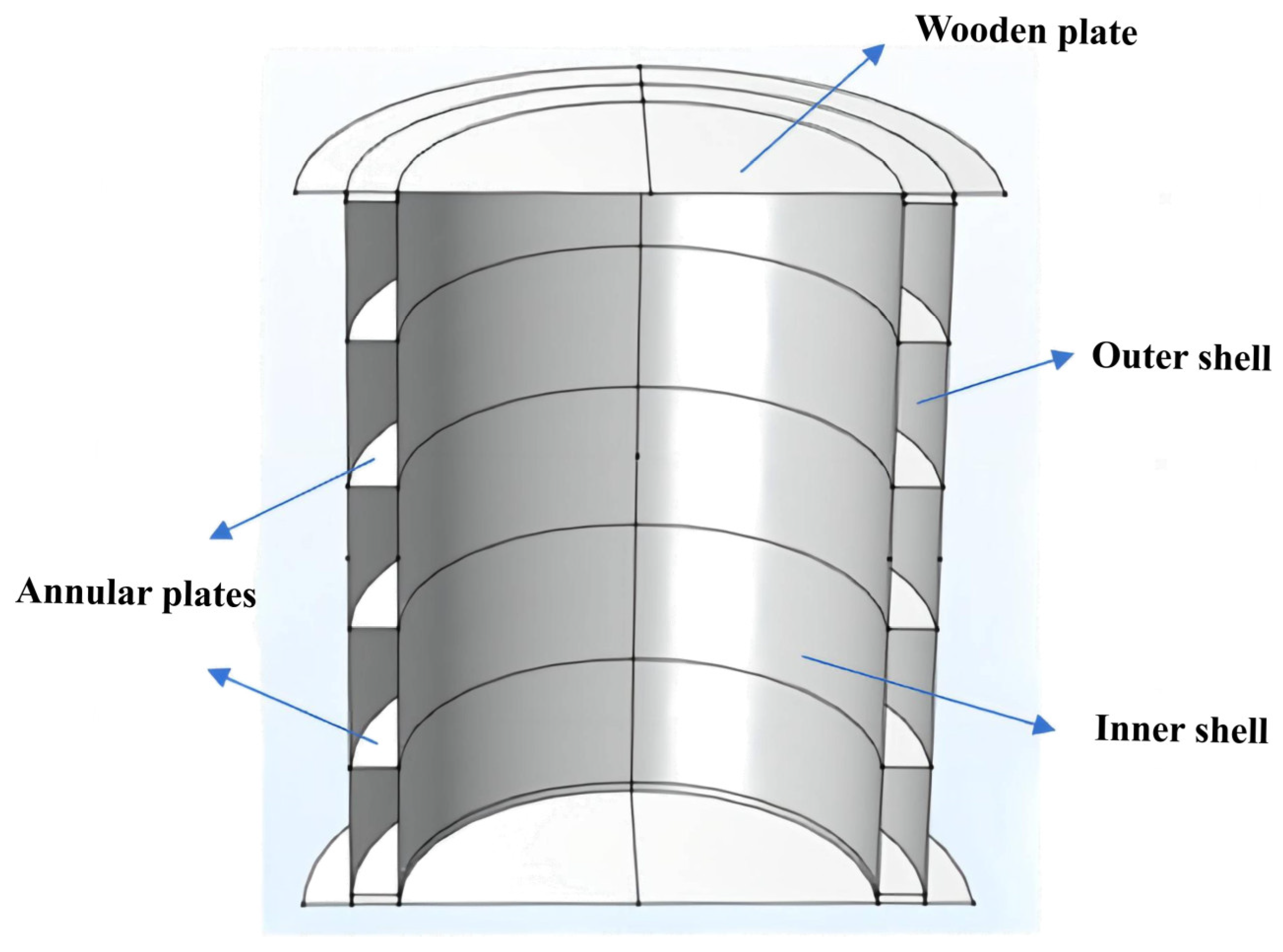
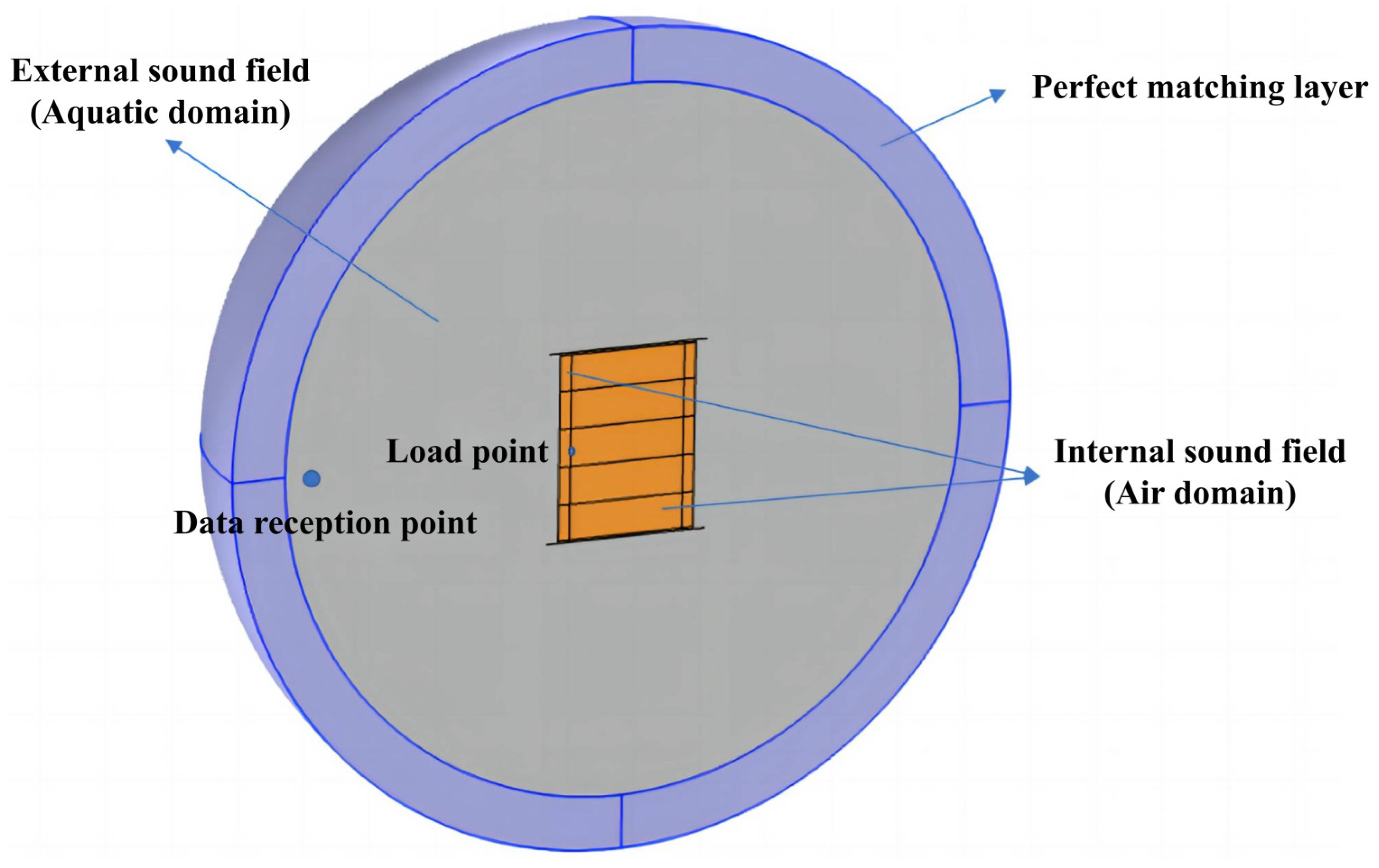
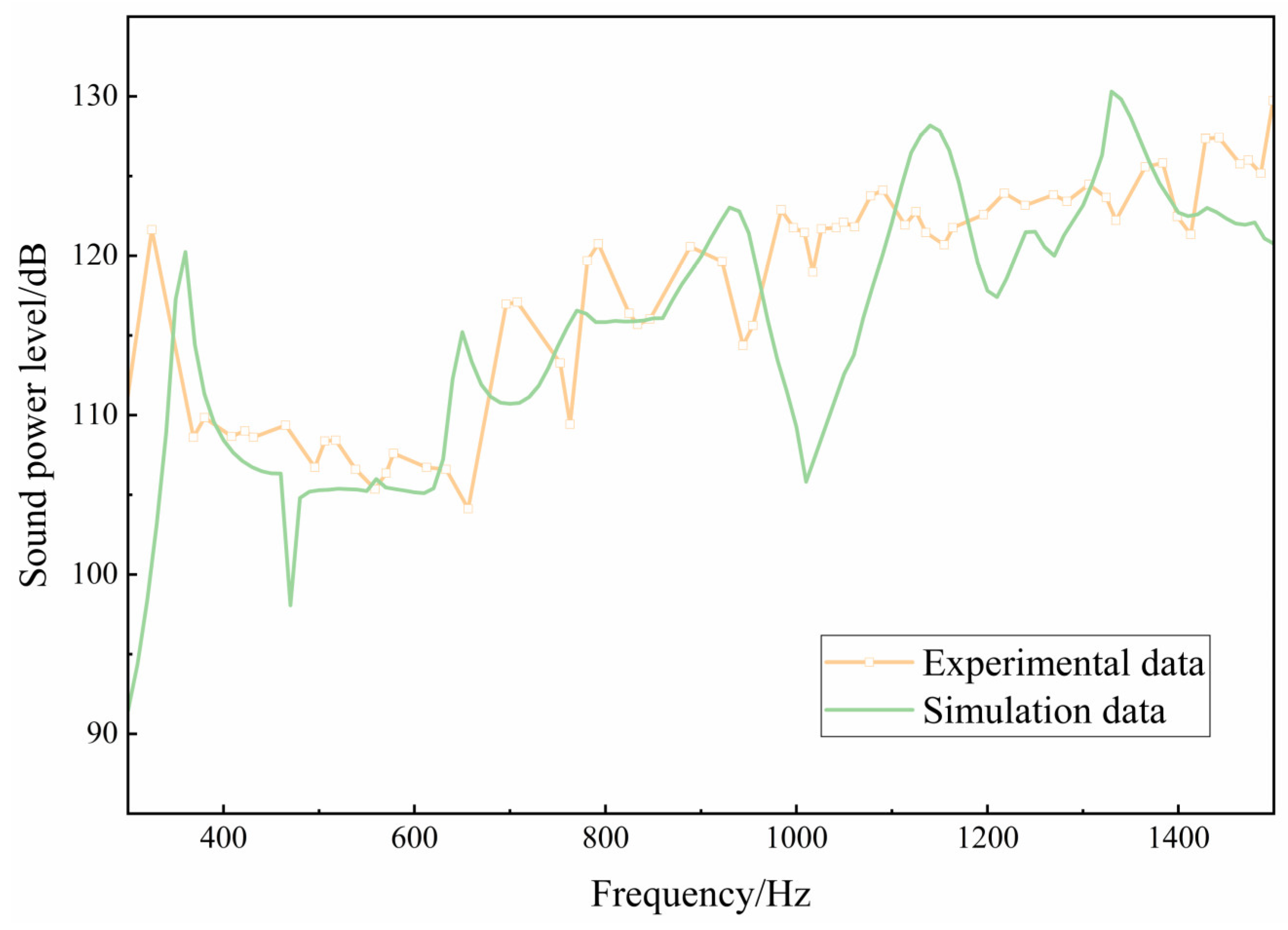
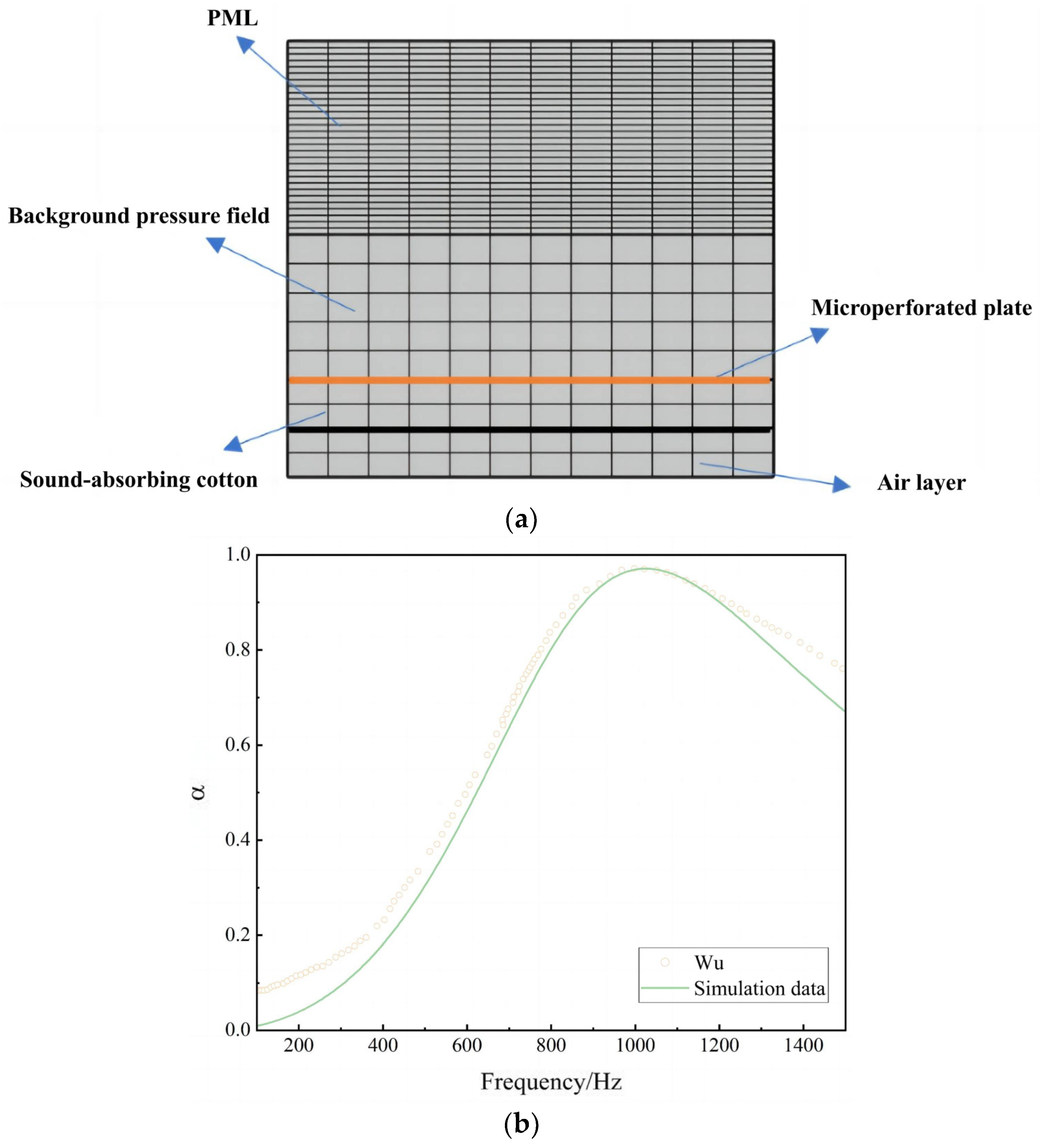
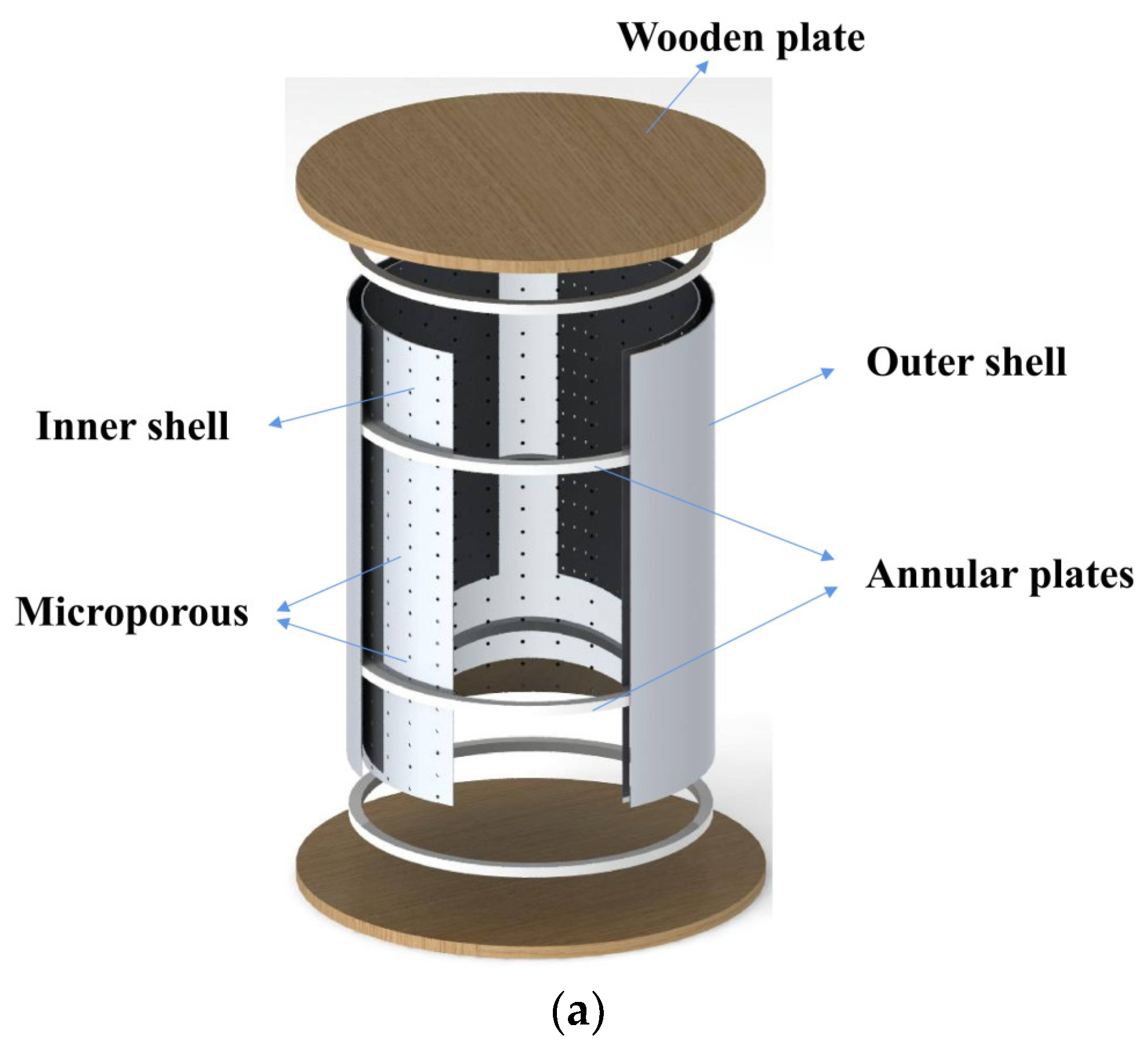
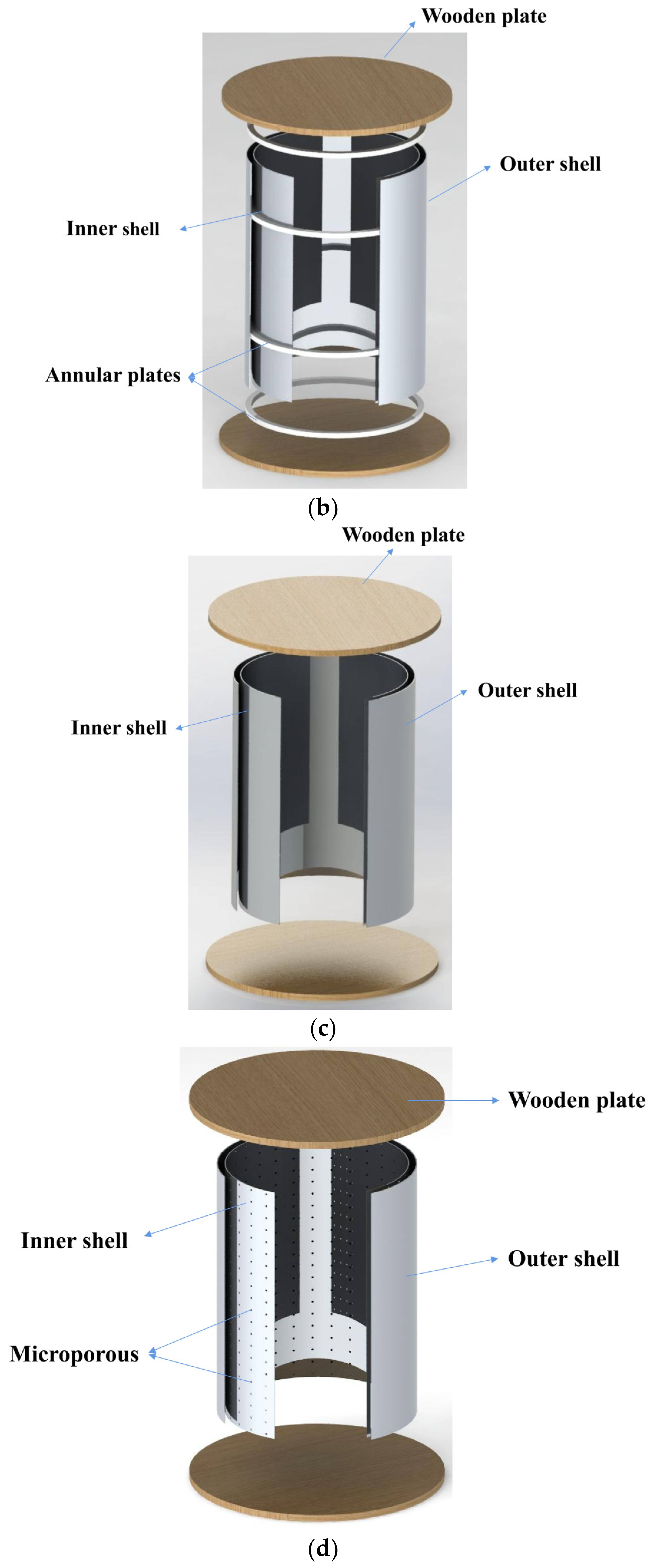
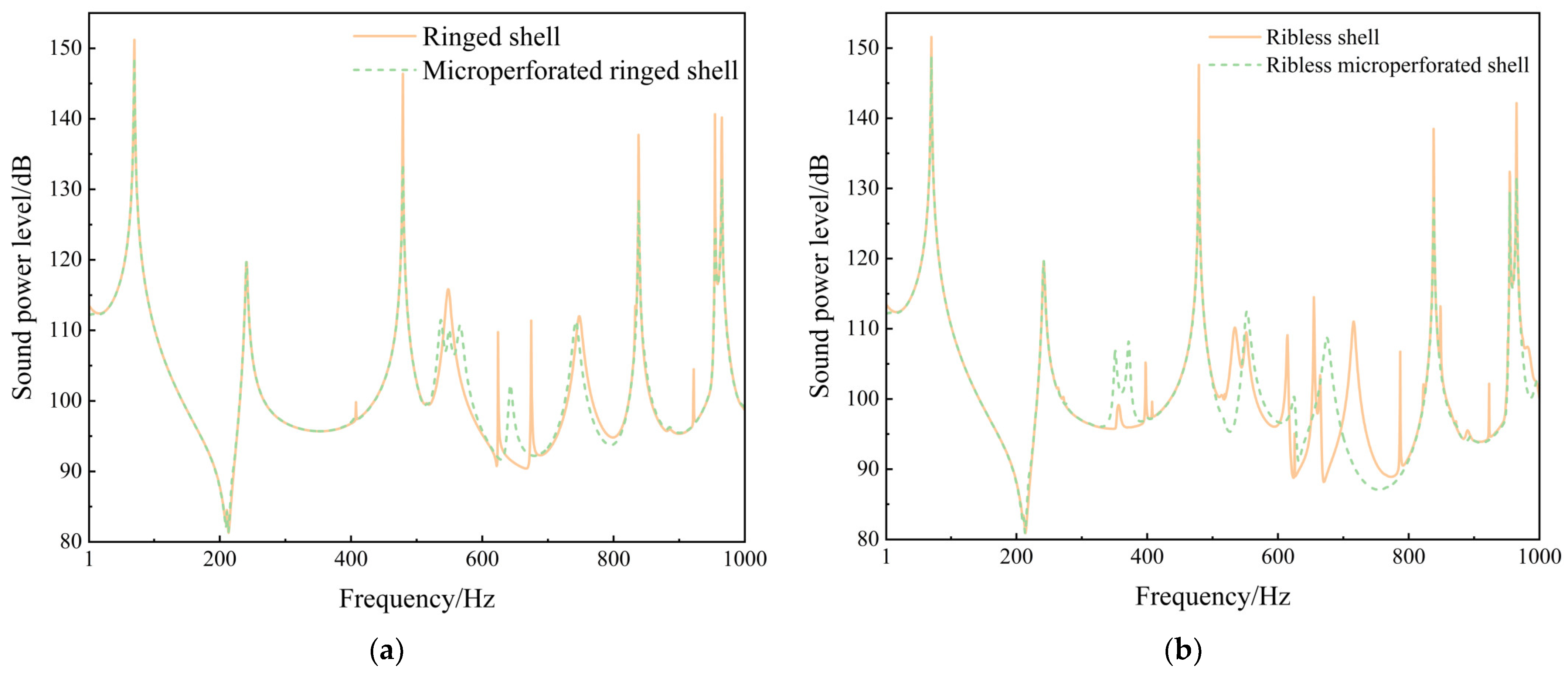

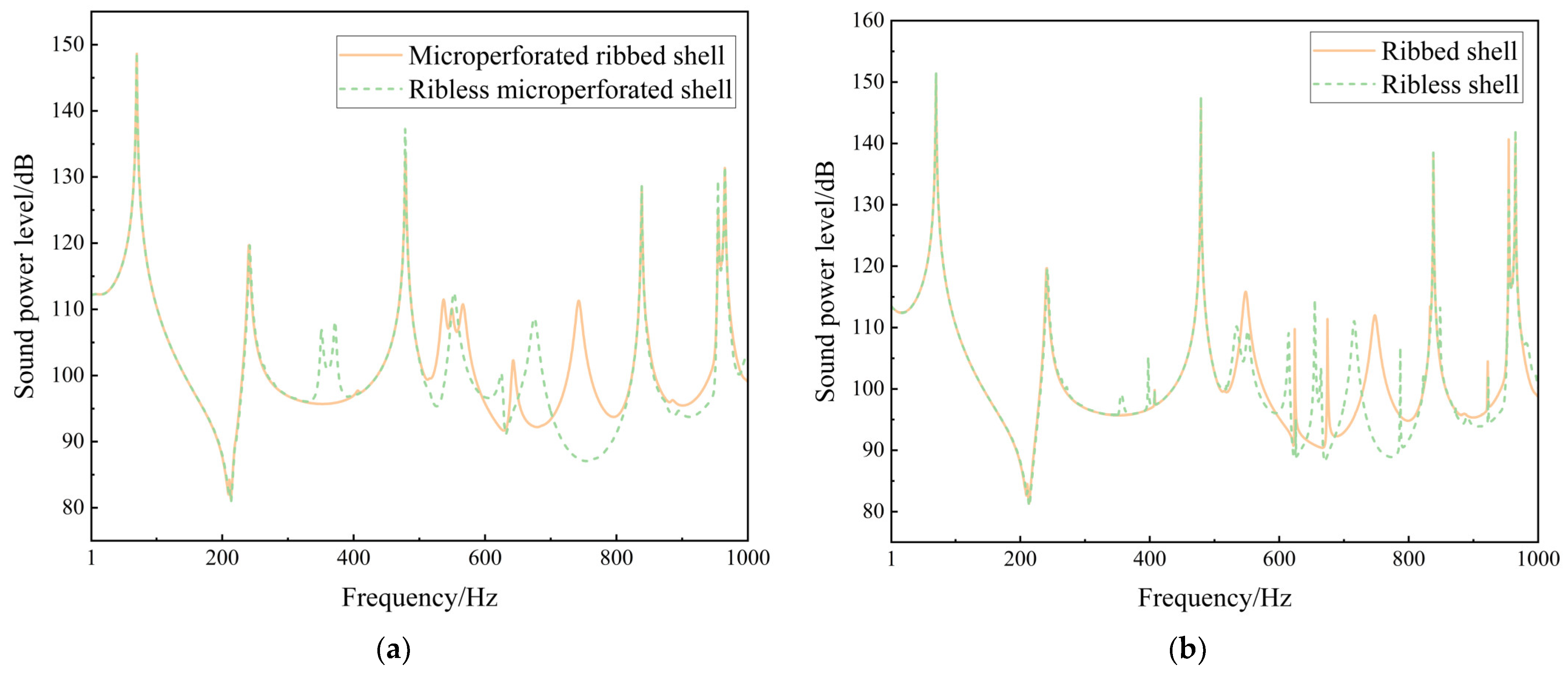

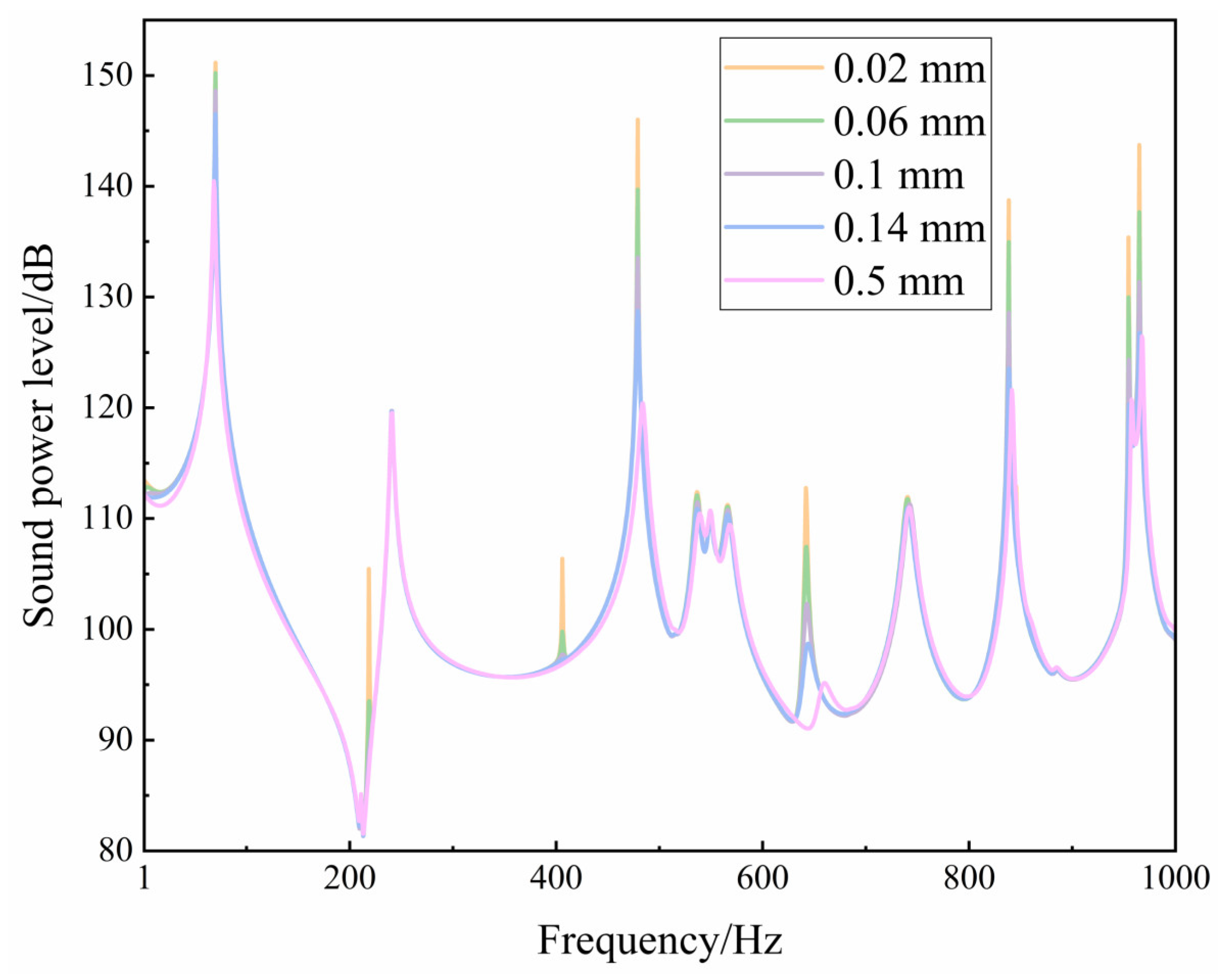
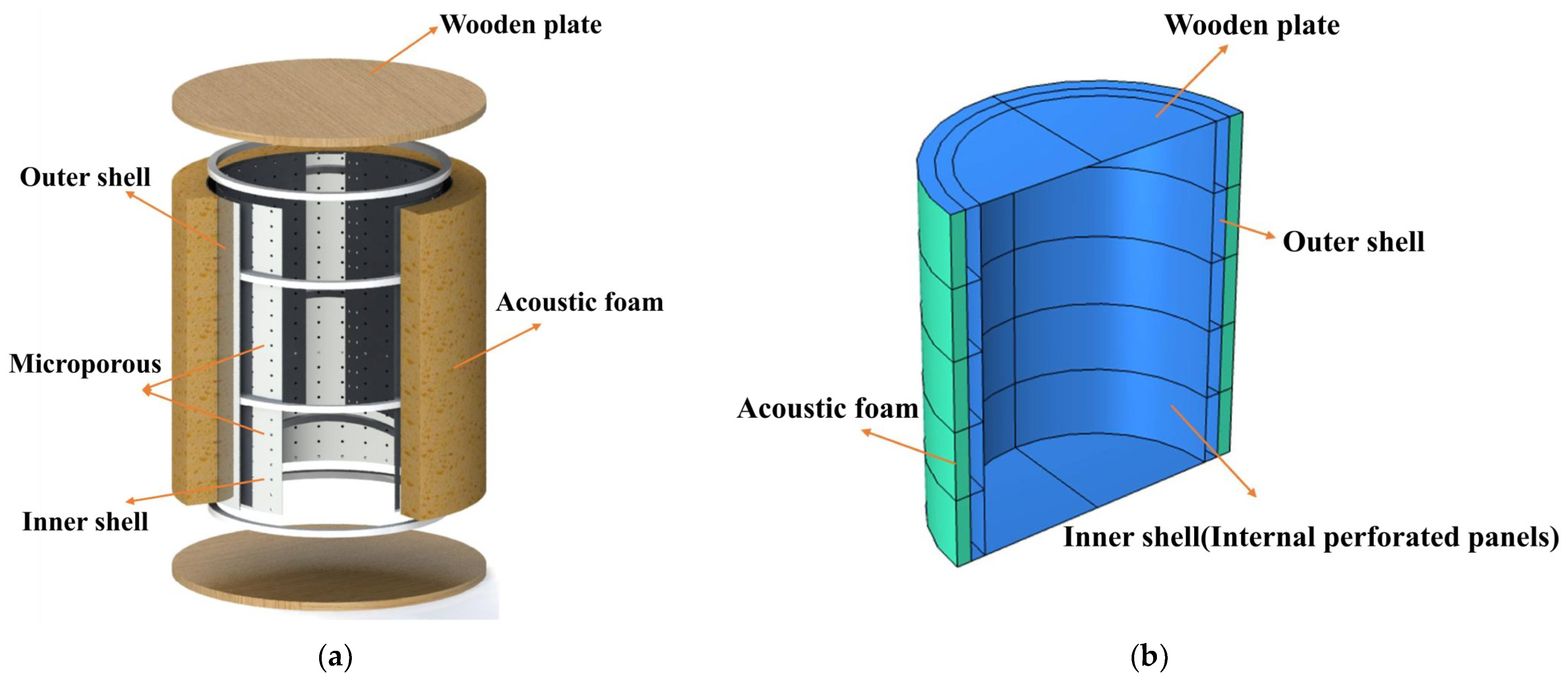
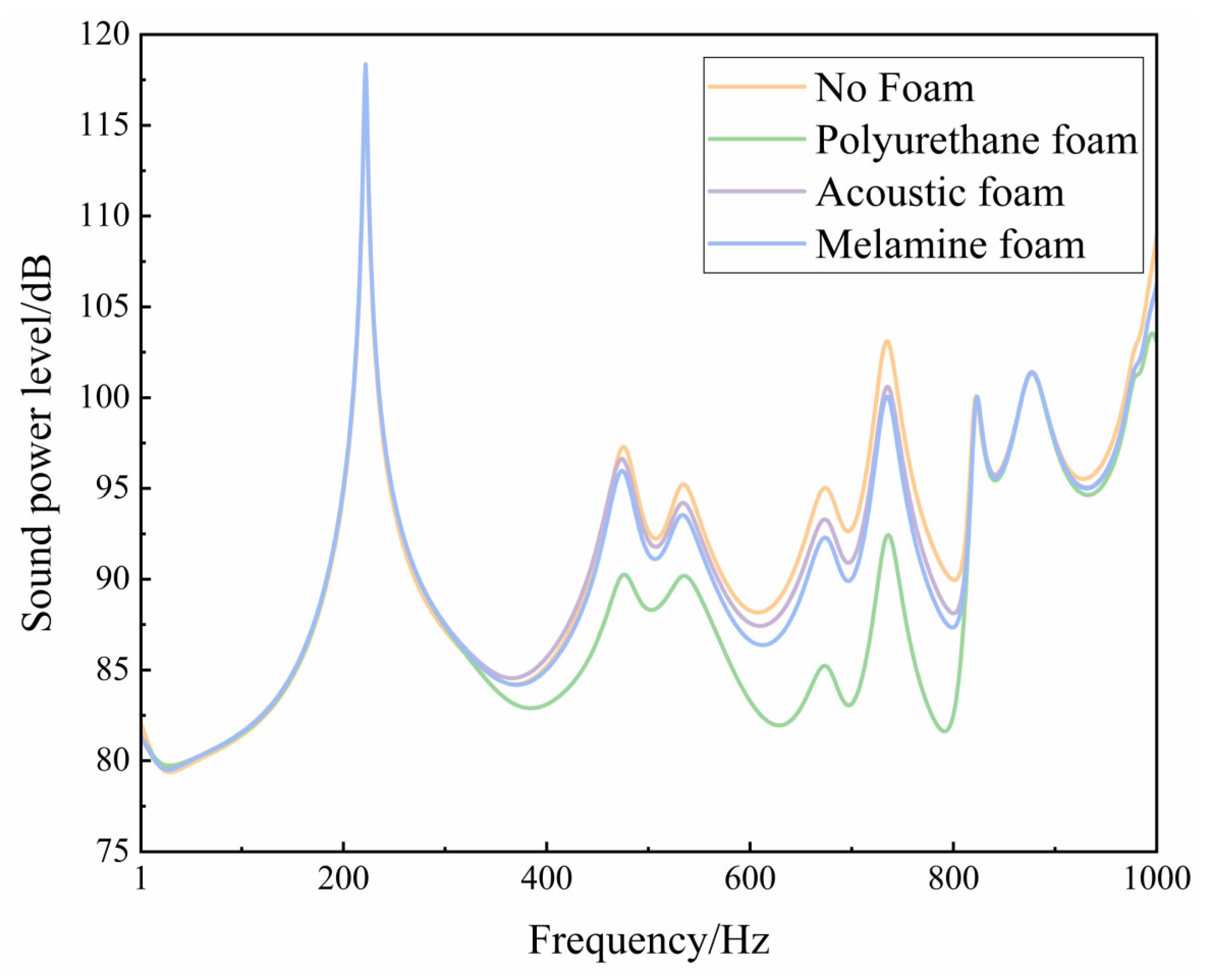
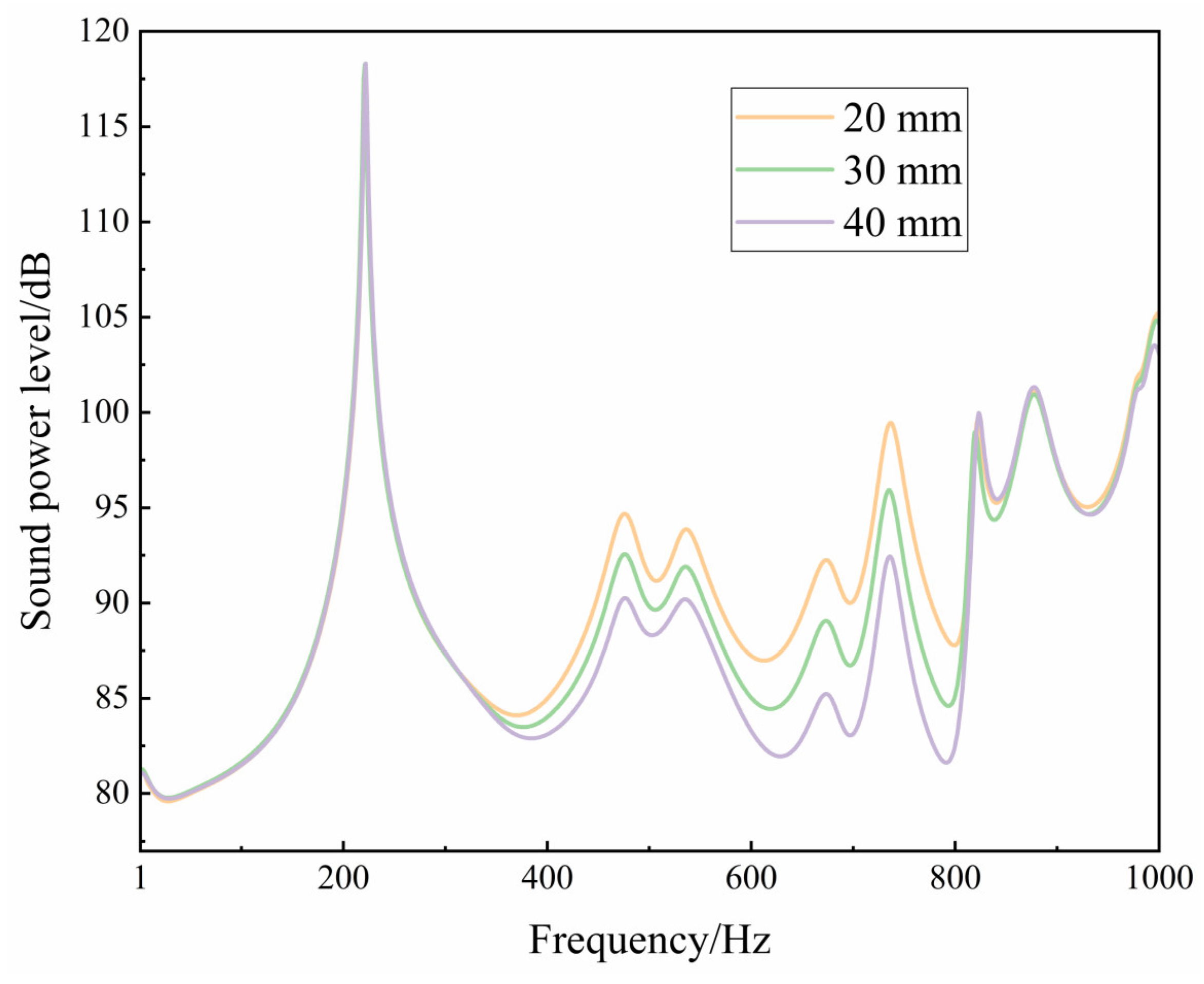

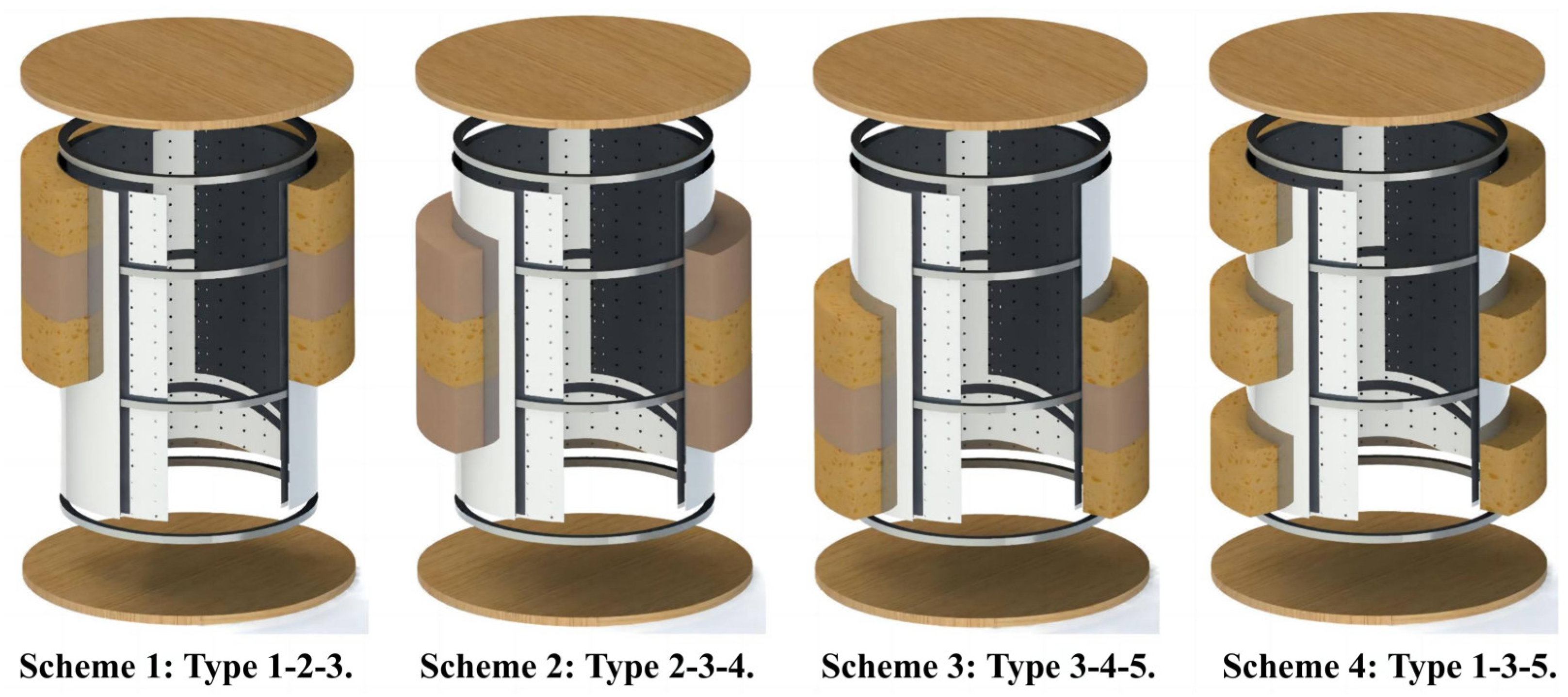

| Material | Density (kg/m3) | Elastic Modulus (GPa) | Poisson’s Ratio | Speed of Sound (m/s) |
|---|---|---|---|---|
| Steel | 7850 | 210 | 0.30 | \ |
| Water | 1000 | \ | \ | 1500 |
| Air | 1.225 | \ | \ | 343 |
| Material | Density (kg/m3) | Elastic Modulus (GPa) | Poisson’s Ratio |
|---|---|---|---|
| Aluminum | 2700 | 70 | 0.30 |
| Material | Density (kg/m3) | Elastic Modulus (GPa) | Poisson’s Ratio |
|---|---|---|---|
| Wood | 800 | 2 | 0.4 |
| Types of Materials | Porosity | Static Flow Resistivity (Pa·s/m2) | Tortuosity Factor | Viscous Characteristic Length (mm) | Thermal Characteristic Length (mm) |
|---|---|---|---|---|---|
| Polyurethane foam | 0.97 | 87,000 | 2.52 | 0.037 | 0.119 |
| Acoustic foam | 0.823 | 15,023 | 1.0 | 0.034 | 0.091 |
| Melamine foam | 0.973 | 13,000 | 1.05 | 0.064 | 0.207 |
Disclaimer/Publisher’s Note: The statements, opinions and data contained in all publications are solely those of the individual author(s) and contributor(s) and not of MDPI and/or the editor(s). MDPI and/or the editor(s) disclaim responsibility for any injury to people or property resulting from any ideas, methods, instructions or products referred to in the content. |
© 2023 by the authors. Licensee MDPI, Basel, Switzerland. This article is an open access article distributed under the terms and conditions of the Creative Commons Attribution (CC BY) license (https://creativecommons.org/licenses/by/4.0/).
Share and Cite
Li, B.; Wang, N.; Zheng, Z.; Kuang, W.; Wei, L.; Chen, Y.; Hou, J.; Chen, S. Study on the Vibration and Sound Radiation Performance of Micro-Perforated Laminated Cylindrical Shells. Appl. Sci. 2023, 13, 11939. https://doi.org/10.3390/app132111939
Li B, Wang N, Zheng Z, Kuang W, Wei L, Chen Y, Hou J, Chen S. Study on the Vibration and Sound Radiation Performance of Micro-Perforated Laminated Cylindrical Shells. Applied Sciences. 2023; 13(21):11939. https://doi.org/10.3390/app132111939
Chicago/Turabian StyleLi, Bin, Ning Wang, Zengquan Zheng, Wenjian Kuang, Langlang Wei, Yihao Chen, Jiangbin Hou, and Shuang Chen. 2023. "Study on the Vibration and Sound Radiation Performance of Micro-Perforated Laminated Cylindrical Shells" Applied Sciences 13, no. 21: 11939. https://doi.org/10.3390/app132111939
APA StyleLi, B., Wang, N., Zheng, Z., Kuang, W., Wei, L., Chen, Y., Hou, J., & Chen, S. (2023). Study on the Vibration and Sound Radiation Performance of Micro-Perforated Laminated Cylindrical Shells. Applied Sciences, 13(21), 11939. https://doi.org/10.3390/app132111939






